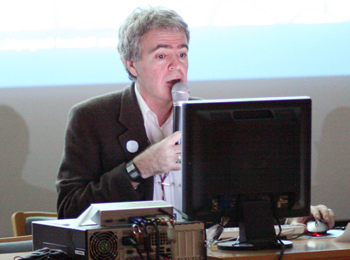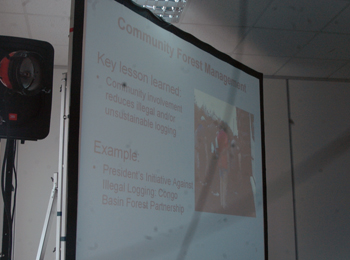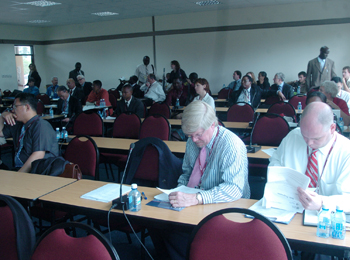 |
||
|
Published by the International Institute for Sustainable Development (IISD)
|
|||
|
A Special Report on Selected Side Events at the Second Conference of the Parties serving as the Meeting of Parties to the Kyoto Protocol (COP/MOP 2) and Twelfth Conference of the Parties (COP 12) to the UN Framework Convention on Climate Change (UNFCCC)
|
|||||
| 6-17 November 2006 | Nairobi, Kenya | |||||
 |
|||
 |
|||
Events convened on Wednesday, 15 November 2006
|
World Energy Outlook 2006: alternative policy scenario and beyond Presented by Germany |
|||
|
Rajendra Pachauri, IPCC Chairman, said the side event aims at discussing the main findings of the “Alternative Policy Scenario” modeled in the “World Energy Outlook 2006” (WEO).
Claude Mandil, International Energy Agency (IEA), outlined the IEA “World Energy Outlook 2006,” which presents a business-as-usual scenario and an alternative policy scenario (APS), which assumes that key policies on GHG emission reductions are implemented. He noted the APS forecasts that focus on improved end-use efficiency could account for over two-thirds of avoided emissions in 2030. He stated that energy efficiency policies benefit economic development and the environment. Achim Steiner, UNEP Executive Director, suggested that “there are no longer easy energy alternatives” and that carbon scenarios show that there will be an absolute constraint on energy supply in the near future. Steiner expressed concern about the way the energy debate has been conducted, particularly regarding feasible scenarios for nuclear energy, which was dismissed 20 years ago due to issues of cost, security and waste disposal. Sigmar Gabriel, Federal Minister for the Environment, Nature Conservation and Nuclear Safety, Germany, said Germany has a target of using 20-25% of renewable energy sources by 2020 and no nuclear energy. Commenting on post-2012 climate policies, he noted governments should advocate a “me too” approach rather than a “you first” approach for saving the climate. On reducing GHG emissions and promoting access to energy, Gabriel suggested further investment in carbon capture and storage (CCS) and technology transfer from developed to developing countries. Peter Carl, European Community (EC), on behalf of Stavros Dimas, EC Commissioner for Environment, noted the important WEO conclusion that it is cheaper to take necessary steps for promoting a declining carbon emission path than to pursue a business-as-usual path. He highlighted that the EU will present an initiative for post-2012 commitments without “waiting for Godot.” Steve Sawyer, REN 21 Global Policy Network, noted the lack of a scenario that models a 50% GHG reduction target that will protect the climate. In the ensuing discussion, one participant highlighted the infeasibility of private investments in CCS technology due to its high cost. |
|||
 |
 |
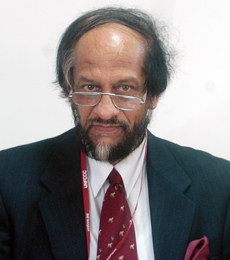 |
|||||
|
Peter Carl, European Community (EC)
|
Steve Sawyer, REN 21 Global Policy Network
|
Rajendra Pachauri, IPCC Chairman
|
|||||
|
|||
|
Learning lessons of community resilience: successes and barriers to reducing vulnerability Presented by Friends of the Earth International |
|||
|
Erasmus Aborley, Friends of the Earth Ghana, described a variety of coping strategies that Africans have developed over time to address climate variability. He stated that poverty and weak institutions impact, and will continue to impact, the ability of Africans to adapt to climate change and described actions to overcome this challenge.
Mozaharul Alam, Bangladesh Centre for Advanced Studies, emphasized that the total funding available for adaptation under the UNFCCC and Kyoto Protocol amount to less than 1% of the funds that the World Bank estimates are needed annually to address adaptation to climate change. He noted that most funding for community-level adaptation comes from development NGOs and not from funds under the UNFCCC. Donald Pols, Friends of the Earth Netherlands, highlighted the World Bank’s high fossil fuel energy investments and low renewable energy and energy efficiency investments. He argued that the World Bank and other financial institutions should invest only in those forms of energy that improve resilience in communities and reflect the sustainable development impact of that energy. He introduced a report by Partners for Innovation, RECIPES project, to be published in 2007, which establishes a sustainable development benchmark that compares the sustainable development impact of different forms of energy. Wangari Maathai, Nobel Peace Prize Laureate, Kenya, stressed that while leadership from governments and "super powers" is necessary, it is people at the grassroots level who will ultimately take action to address issues relating to climate change and poverty. |
|||
|
|||
|
Climate and forests: the case for action now Presented by IES |
|||||
|
Tom Spencer, Institute for Environmental Security (IES), noted the urgency of saving tropical forests, highlighting that those concerned should not wait for the COP/MOP process.” Antonio Donato Nobre, Fenix Amazonica, discussed the links between the Amazonian forests and climate change, describing the rainfall and weather mechanisms in an undisturbed rainforest and highlighting Amazonica's other peculiar features such as wind patterns and biodiversity. He suggested that the changing climate is affecting the natural system dynamics of the Amazon, which is leading to further climate change. Durwood Zaelke, International Network for Environmental Compliance and Enforcement, suggested that conserving forests is essential to taking action on reducing emissions. He noted that while a number of arguments exist to exclude forests from the climate regime, such as the inability to enforce a strong enforcement and compliance mechanism, there is considerable experience available in building such a system. Anders Wijkman, Member of the European Parliament, noted that the need to protect biodiversity for safeguarding eco-services and suggested that the CDM mechanism is too complicated to be used to protect forests. Ian Swingland, Sustainable Forest Management, noted that global forests should not be left out of EU Emission Trading Scheme and urged the need for reform of CDM rules of afforestation and reforestation. Participants discussed whether forests will be saved through CDM and UNFCCC activities and the inability of CDM to provide signals for energy investments in large countries. |
|||||
|
|||
|
Focus on Africa: US partnerships on energy, clean development and climate change Presented by United States of America |
|||
|
Paula Dobriansky, Under Secretary of State for Global Affairs, US, underscored the priority that the US places on collaboration with Africa, including to minimize HIV/AIDS, protect natural resources and promote increased exports from Africa. She highlighted several collaborative initiatives to achieve these goals.
Jan Lewandrowski, Department of Agriculture, US, highlighted the US’ integrated approach to address deforestation, noting that a comprehensive approach consists of three components: market-based approaches; increased community participation; and forest conservation. He emphasized the role of public private partnerships and measuring and monitoring in effectively addressing deforestation and outlined several US programs in Africa. John Furlow, US Agency for International Development, described US contributions to climate observations, decision support and adaptation in Africa. He overviewed the US Global Climate Observing systems as an example of a climate observation system. Furlow elaborated, inter alia, the National Oceanic and Atmospheric Administration Climate Prediction Center, including its Africa desk, and the Famine Early Warning System Network as examples of decision-support systems. He highlighted projects in Mali and South Africa to address adaptation. Susan Wickwire, Environmental Protection Agency, US, presented on US cooperation on energy and climate activities in Africa. She said the US uses multiple approaches in their projects to achieve multiple benefits, including: economic development; energy access and security; public health; and GHG emission reductions. She highlighted several examples of projects throughout Africa. Participants discussed the role of training, education and financing in scaling up projects, public private partnerships and the relative importance of awareness versus access with regards to technology and information. |
|||
 |
 |
 |
|||||
|
Jane Ngige, Kenya Flower Council
|
Njeri Wamukonya, UNEP
|
Frank Pinto, UNDP
|
|||||
|
|||
|
Projects that address climate change and poverty reduction within Southern Africa Presented by SSN |
|||
|
Steve Thorne, South South North (SSN), highlighted an SSN project to address climate change, noting that the project aimed to use climate as an entry point for reducing poverty, maximizing benefits to the South, and creating innovative strategies towards adaptation and mitigation.
Lester Malgas, SSN, South Africa, spoke on programmatic CDM, focusing on projects in low-cost housing in Kuyasa, South Africa. Pamela Semiono, TATEDO, discussed a biodiesel project in Tanzania and outlined some of the criteria for the project’s selection, including its economic potential, the escalation of fuel prices, energy security and soil conservation. Alberto Tsamba, GED, discussed a biogas project for household energy in Mozambique, highlighting that there is a high depletion of forest resources for meeting household energy demand in Changara, Mozambique. Oscar Kibazohi, Environmental Protection and Management Services, Tanzania, noted the socioeconomic problems associated with lack of reliable safe drinking water in Tanzania and elaborated on a project that is being formulated in this regard. Adéle Arendse, SSN, South Africa, summarized a project focusing on sustainable water demand management in urban communities in Khayelitsha, Cape Town. She said that one of the aims of the “Water Leaks Project” is to identify hotspots that are vulnerable to climate change and that the current phase is related to exploring how “to do” adaptation. Boaventura Cuamba, GED, presented a project on the use of photovoltaic systems for drawing water from wells in Mozambique. Participants discussed whether methodology for biodiesel has been developed and the environmental assessment of the biodiesel Jatropha project. |
|||
 |
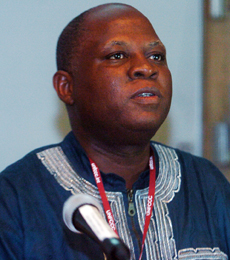 |
 |
|||||
|
Oscar Kibazohi, Environmental Protection and Management Services, Tanzania
|
Boaventura Cuamba, GED
|
Lester Malgas, SSN
|
|||||
|
|||
|
Enhancing understanding of vulnerability and implementation of adaptation to climate change Presented by UNEP |
|||
|
Kilaparti Ramakrishna, UNEP, presented UNEP’s work to advance adaptation to climate change, including: partnerships, information and awareness raising; and capacity building for adaptation and demonstration projects.
Norberto Fernandez, UNEP, noted UNEP’s publications that promote public awareness and environmental information, such as the “Global Environment Outlook” report, the “Global Resources Information" database, the “One planet many people: atlas of our changing environment” and the “Africa’s lakes: atlas of our changing environment.” Catherine Vallee, UNEP, highlighted the challenge of bridging the gap on adaptation knowledge through capacity building on issues, including: national capacity for early warning systems; and training on coastal zone management and sea-level rise. She concluded that adaptation is an environmental and developmental issue, and stressed the importance of initiatives identifying and managing emerging environmental threats. Jon Barnett, University of Melbourne, pointed out that promoting basic political rights and freedom for poor communities is one of the major challenges for effective policy to reduce vulnerability. He suggested that the UN further works on promoting basic human rights and addressing social consequences relating to conflicts. Olav Kjørven, UNDP, highlighted the importance of addressing ways vulnerable societies can adapt to climate change. He noted UNEP’s key role in providing scientific and methodological information for decision makers. Sumaya Zaki Eldeen, Khartoum University, Sudan, underscored the need for further work regarding modeling of socioeconomics and environmental economics to assist the elaboration of national communications of least developed countries. She noted the lack of institutional and government stability as a major institutional barrier for adaptation policies in some LDCs. She highlighted the importance of local NGOs in promoting institutional capacity building that could help mainstream adaptation in national policies and programmes. Louis Verchot, World Agroforestry Centre, said that the challenges to effective policy changes for reducing vulnerability in Africa include: a general lack of awareness of climate change as an important issue that is not only an environmental but also a developmental issue; and the need to involve planning and finance ministers in the climate debate and to understand the urgency of climate change. |
|||
|
|||
|
||
|
Click the above button to go back to our ENB main coverage
|
||
|
|
|
|
|
||
|












